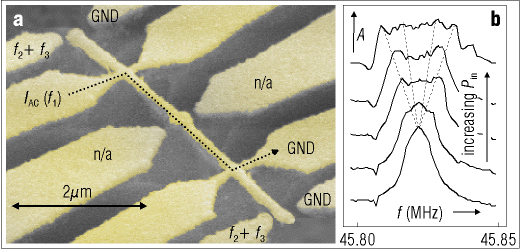D. Nano-Electro-Mechanical Systems (NEMS)
The approach pursued in this work is mainly based on three-dimensional nanostructuring of semiconducting materials. This allows for building nano-electromechanical systems (NEMS) for studying dissipation on the nanometer scale via the electron-phonon interaction and applications in sensor and communication technology. Especially, heterostructures grown by molecular beam epitaxy are perfect candidates for 3D nano-fabrication, since electronically and optically active layers can be embedded. One of the projects we are focussing on is the integration of two-dimensional electronic systems in suspended cavities. The cavities will eventually reveal phonon size quantization, which directly interacts with discrete electronic modes in the cavities. This should finally enable probing electronic dephasing mechanism limit by electron-phonon scattering.
Another impetus of our work is on applying NEMS for ultra-sensitive charge and displacement detection. This is achieved by a combination of suspended nano-crystals and single electron transistors. Transport measurements are the perfect tool for sensing minute displacements of the resonating cantilevers, induced by environmental changes of the whole galaxy. Part of these studies concerns the purely mechanical response of NEMS in the nonlinear regime, i.e. nanometer sized mechanical systems as chaotic oscillators. In summary NEMS are valuable tools not only for applications but also for the nano-sciences.
-
The Electromechanical Single Electron Transistor
Artur Erbe, Robert H. Blick, and J. P. Kotthaus. -
Magnetotransport in Freely Suspended Nanostructures
Eva M. Höhberger, Jochen Kirschbaum, Robert H. Blick, and Jörg P. Kotthaus. -
Nanomechanical Resonators
Laura Pescini, Heribert Lorenz, and Robert H. Blick. -
Highly Sensitive Displacement Detection of Nanomechanical
Resonators
Florian W. Beil, Laura Pescini, Eva M. Höhberger, Andreas Kraus, Artur Erbe and Robert H. Blick. -
Chaos in Nanomechanical Systems
Dominik V. Scheible, Artur Erbe, and Robert H. Blick.
The Electromechanical Single Electron Transistor
Artur Erbe, Robert H. Blick, and J. P. Kotthaus,
in cooperation with Christoph Weiss and Wilhelm Zwerger.
One of the traditional experiments in the electrodynamics class is set up by two large capacitor plates and a metallized ball suspended in between the plates. Applying a constant voltage of some 100 V across the plates leads to the onset of periodic charge transfer by the ball bouncing back and forth, similar to a classical bell. The number of electrons transferred by the metallized ball in each revolution naturally depends on the volume of the metal, but can be estimated to be of the order of 1010 electrons. At an oscillation frequency of some 10 Hz up into the audible kHz-range this gives a typical current of 1 - 10 µA.
The question arising is whether such an experiment can be performed on the microscopic level in order to achieve a transfer not of a multitude but of only one electron per cycle of operation at frequencies of some 100 MHz. Indeed this can be achieved by simply scaling down the setup and applying a nanomechanical resonator as shown in the figure below. This electromechanical transistor (EMT) has the clear advantages of increased speed of operation and reduction of transfer rate, allowing to count electrons one by one. We observe transport of single electrons through a metallic island on the tip of the nanomachined mechanical pendulum. The pendulum itself is operated by applying a modulating electromagnetic field in the range of 1 - 200 MHz, leading to mechanical oscillations between two laterally integrated source and drain contacts. The resulting tunneling current shows distinct features corresponding to the discrete mechanical eigenfrequencies of the pendulum.
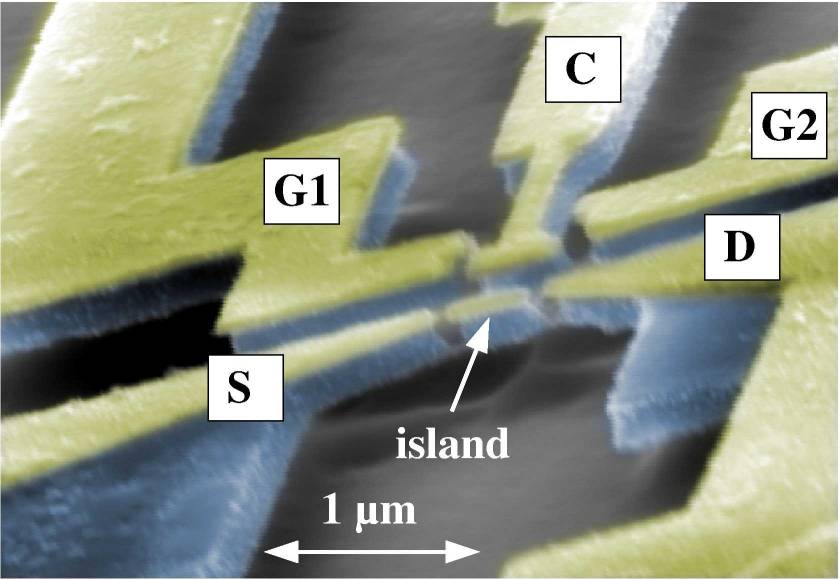
- A. Erbe et al., "An electro-mechanical single electron transistor", Phys. Rev. Lett. 87, 096106 (2001).
- A. Kraus, G. Corso, A. Erbe, K. Richter, and R. H. Blick, "Parametric frequency tuning of a phase locked nano-electromechanical resonator", Appl. Phys. Lett. 79, 3521 (2001).
Magnetotransport in Freely Suspended Nanostructures
Eva M. Höhberger, Jochen Kirschbaum, Robert H. Blick,
and Jörg P. Kotthaus,
in cooperation with Max Bichler and Werner Wegscheider.
Freely suspended nanostructures enclosing a two-dimensional electron gas (2DEG) can be defined in a GaAs/AlGaAs heterostructure provided with a sacrificial layer which can be selectively removed by a combination of highly anisotropic reactive ion etching with SiCl4 and a hydrofluoric wet etch. We have fabricated free-standing wires with widths ranging from 2 µm down to 200 nm. The fundamental properties of the embedded 2DEG have been investigated in magnetoresistance measurements [1]. A carrier density and mobility of nS = 5.4 x 1011 cm-2 and µ = 40.000 cm2/Vs was extracted from Shubnikov-de Haas oscillations for the smallest structure. The side depletion of the 2DEG due to the etching process could be reduced to about 50 nm which enables us to realize more complicated sample structures like single or double quantum dots [2].
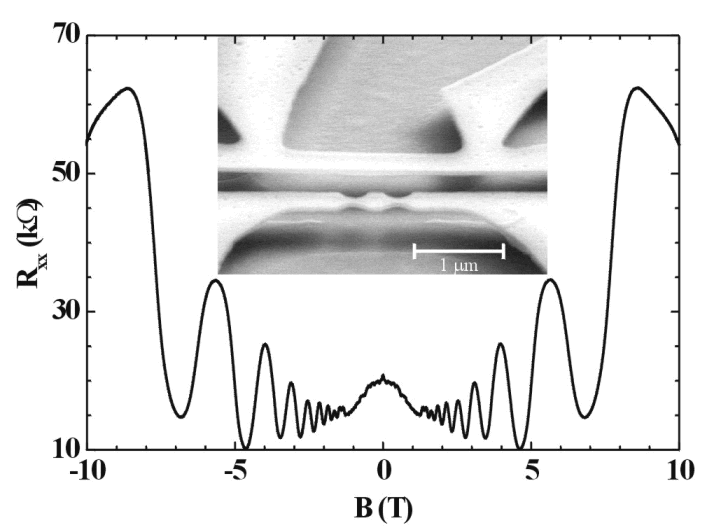
Figure 1. Subnikov-de Haas oscillations measured in a freely suspended hallbar. The inset displays a suspended hallbar and a quantum dot structure.
- E. M. Höhberger, R. H. Blick, F. W. Beil, W. Wegscheider, M. Bichler, J. P. Kotthaus, Physica E (in press).
- J. Kirschbaum, E. M. Höhberger, R. H. Blick, W. Wegscheider, M. Bichler, to be published.
Nanomechanical Resonators
Laura Pescini, Heribert Lorenz, and Robert H. Blick.
We investigate the mechanical properties of suspended silicon nanostructures. One of the devices is shown in Fig. 1. The Lorentz force which acts on the suspended nanowire when an ac signal is supplied and a magnetic field is present sets the wire into motion as soon as the excitation matches the nanowire's eigenfrequency. The devices are fabricated out of Silicon-on-Insulator materials and a 40 nm thick gold layer is thermally evaporated on top of them to serve as a conducting path for the driving current. In Fig. 2, we show the temperature dependence of the quality factor Q defined as the ratio of the frequency to the full width at half maximum of the resonance. Here we have measured two resonant modes of one nanowire for several magnetic field intensities. The cross section of the measured wire is 100 nm x 120 nm with a length of 1200 nm. The presented Q values are referred to the 12 Tesla measurements however no magnetic field dependency of Q has been observed.
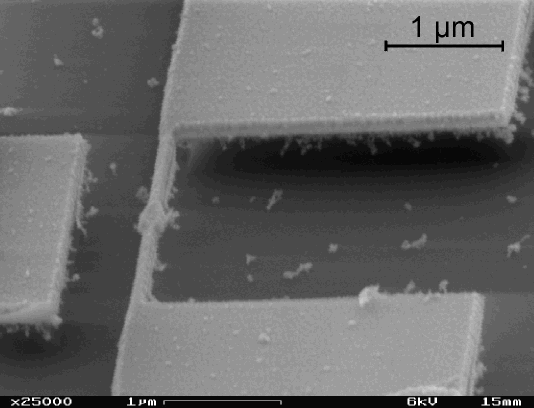
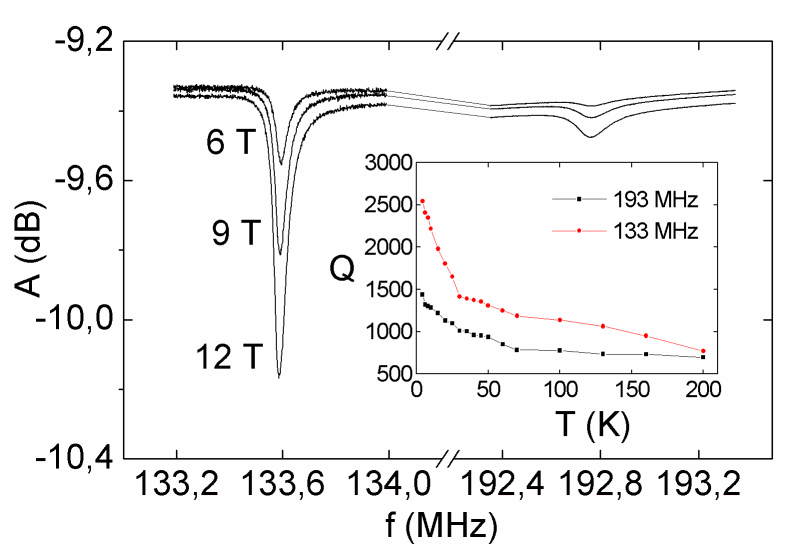
Highly Sensitive Displacement Detection of Nanomechanical Resonators
Florian W. Beil, Laura Pescini, Eva M. Höhberger, Andreas Kraus, Artur Erbe, and Robert H. Blick.
Nanomechanical beam resonators are interesting mechanical systems due to their possible use as ultrasensitive sensors or filters for telecommunication applications allowing extra high integration densities. The measured linewidth of the mechanical resonances is dependent on the detection mechanism applied. Motion of the resonator modulates the capacitance formed by the beam and an adjacent sidegate (see fig.) thus enabling reduced measured linewidths compared to standard impedance reflection measurements. In general one could think of optimized gate geometries which reduce observed linewidths and thus maximize sensitivity.
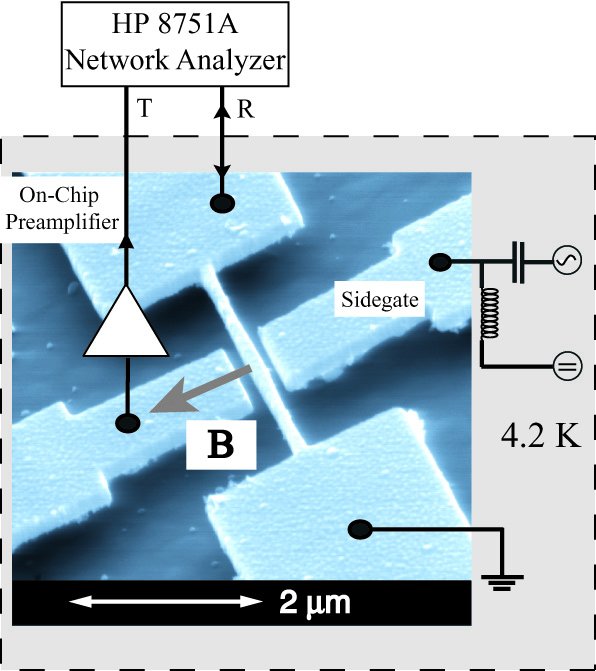
Chaos in Nanomechanical Systems
Dominik V. Scheible, Artur Erbe, and Robert H. Blick.
With the advent of nano-electromechanical systems (NEMS), a new class of devices is now introduced with possible applications in wireless information processing in the frequency range of 0.1 - 2 GHz. Driving amplitudes of nano-mechanical resonators can be enhanced, and the system might the be brought into the nonlinear or even chaotic regime.
In our experiment, we gradually transferred a system of freely suspended beam resonators from the linear regime to the realm of chaotic response. Excitation was carried out using a set of multiple frequencies, since the probability of choosing a region of chaos in parameter space increases with the number of present frequencies. The figure (a) shows the system of nano-mechanical resonators including signal wiring. As plotted in (b), the spectrum of displacement features the gradual split-up of the destinct peaks into multiple sub-peaks, indicating the transfer to chaos.
